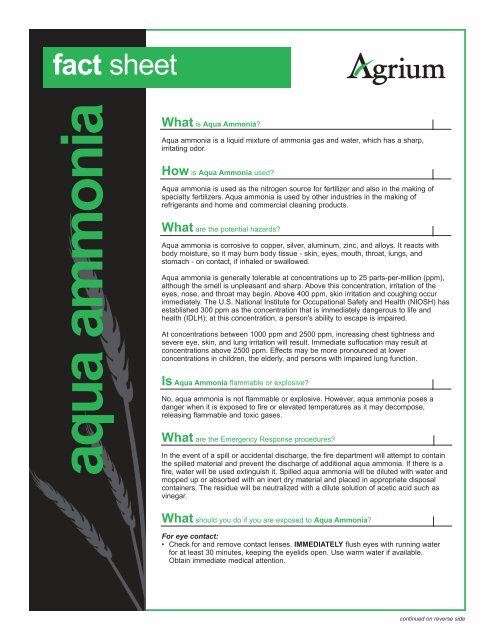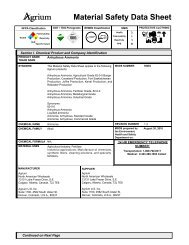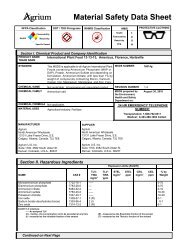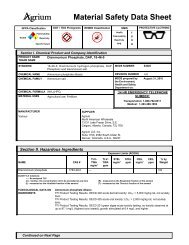Aqua ammonia.qxd - Agrium Wholesale
Aqua ammonia.qxd - Agrium Wholesale
Aqua ammonia.qxd - Agrium Wholesale
You also want an ePaper? Increase the reach of your titles
YUMPU automatically turns print PDFs into web optimized ePapers that Google loves.
fact sheet<br />
aqua <strong>ammonia</strong><br />
What is <strong>Aqua</strong> Ammonia?<br />
<strong>Aqua</strong> <strong>ammonia</strong> is a liquid mixture of <strong>ammonia</strong> gas and water, which has a sharp,<br />
irritating odor.<br />
How is <strong>Aqua</strong> Ammonia used?<br />
<strong>Aqua</strong> <strong>ammonia</strong> is used as the nitrogen source for fertilizer and also in the making of<br />
specialty fertilizers. <strong>Aqua</strong> <strong>ammonia</strong> is used by other industries in the making of<br />
refrigerants and home and commercial cleaning products.<br />
What are the potential hazards?<br />
<strong>Aqua</strong> <strong>ammonia</strong> is corrosive to copper, silver, aluminum, zinc, and alloys. It reacts with<br />
body moisture, so it may burn body tissue - skin, eyes, mouth, throat, lungs, and<br />
stomach - on contact, if inhaled or swallowed.<br />
<strong>Aqua</strong> <strong>ammonia</strong> is generally tolerable at concentrations up to 25 parts-per-million (ppm),<br />
although the smell is unpleasant and sharp. Above this concentration, irritation of the<br />
eyes, nose, and throat may begin. Above 400 ppm, skin irritation and coughing occur<br />
immediately. The U.S. National Institute for Occupational Safety and Health (NIOSH) has<br />
established 300 ppm as the concentration that is immediately dangerous to life and<br />
health (IDLH); at this concentration, a person's ability to escape is impaired.<br />
At concentrations between 1000 ppm and 2500 ppm, increasing chest tightness and<br />
severe eye, skin, and lung irritation will result. Immediate suffocation may result at<br />
concentrations above 2500 ppm. Effects may be more pronounced at lower<br />
concentrations in children, the elderly, and persons with impaired lung function.<br />
Is <strong>Aqua</strong> Ammonia flammable or explosive?<br />
No, aqua <strong>ammonia</strong> is not flammable or explosive. However, aqua <strong>ammonia</strong> poses a<br />
danger when it is exposed to fire or elevated temperatures as it may decompose,<br />
releasing flammable and toxic gases.<br />
What are the Emergency Response procedures?<br />
In the event of a spill or accidental discharge, the fire department will attempt to contain<br />
the spilled material and prevent the discharge of additional aqua <strong>ammonia</strong>. If there is a<br />
fire, water will be used extinguish it. Spilled aqua <strong>ammonia</strong> will be diluted with water and<br />
mopped up or absorbed with an inert dry material and placed in appropriate disposal<br />
containers. The residue will be neutralized with a dilute solution of acetic acid such as<br />
vinegar.<br />
What should you do if you are exposed to <strong>Aqua</strong> Ammonia?<br />
For eye contact:<br />
• Check for and remove contact lenses. IMMEDIATELY flush eyes with running water<br />
for at least 30 minutes, keeping the eyelids open. Use warm water if available.<br />
Obtain immediate medical attention.<br />
continued on reverse side
fact sheet<br />
Where can I get more<br />
information?<br />
For more information on this<br />
product, or other <strong>Agrium</strong><br />
products, please call <strong>Agrium</strong><br />
directly at (403) 225-7000.<br />
Information can also be<br />
found at the following<br />
websites:<br />
• Agency for Toxic<br />
Substances and Disease<br />
Registry (ATSDR):<br />
www.atsdr.cdc.gov<br />
• Occupational Health and<br />
Safety Administration<br />
(OSHA): www.osha.gov<br />
• Canadian Centre for<br />
Occupational Health and<br />
Safety: www.ccohs.ca<br />
<strong>Agrium</strong><br />
13131 Lake Fraser Drive S.E.<br />
Calgary, Alberta<br />
T2Y 7E8<br />
Telephone:<br />
(403) 225-7000<br />
www.agrium.com<br />
For skin contact:<br />
• Remove contaminated clothing as quickly as possible. Flush exposed skin with large<br />
amounts of water for at least 30 minutes. Use warm water if available. If irritation<br />
persists, seek medical attention. Dispose of contaminated clothing in a manner that<br />
limits further exposure.<br />
For minor inhalation:<br />
• Using appropriate respiratory protection, remove the affected individual from the area<br />
of overexposure. Allow the person to rest in a well-ventilated area. If irritation persists,<br />
obtain medical attention.<br />
For severe inhalation:<br />
• Use proper respiratory protection to evacuate affected individuals to a safe area as<br />
soon as possible. Loosen tight clothing around the person's neck and waist. If<br />
breathing is difficult administer oxygen. If the person is not breathing, perform artificial<br />
respiration and obtain immediate medical attention.<br />
For ingestion:<br />
• Do not induce vomiting. Careful removal of the <strong>ammonia</strong> from the stomach by medical<br />
personnel is required. Call a physician or poison control center and seek immediate<br />
medical attention. If tolerated, give no more than 1 cup of milk or water to rinse the mouth<br />
and throat and dilute the stomach contents. No more than 8 ounces (1 cup) in adults and<br />
4 ounces (1/2 cup) in children are recommended to minimize the risk of vomiting.<br />
What should you do in the event of a spill?<br />
Follow any special instructions given over the radio, T.V., or by someone in authority. If<br />
there is a fire or an explosion, stay away from the site. Follow standard, marked<br />
emergency routes or directions from police to travel to your destination.<br />
If there has been a release of toxic vapors:<br />
• Go indoors immediately and close all doors, windows, and openings.<br />
• Turn on your radio or television to a local news station. (Be prepared to wait a few<br />
minutes for news.)<br />
• Follow any special instructions given over the radio or television, or by someone in<br />
authority.<br />
• Shut off all air conditioning units, fans, ventilation systems and clothes dryers. In<br />
winter, turn your furnace to its lowest setting and close fireplace dampers.<br />
• Evacuate only if advised to do so by local authorities.<br />
You may wish to:<br />
• Place wet towels at the base of doors or breathe through damp towels.<br />
• Bring in pets if they are nearby and easily found.<br />
Unless you are told to do so by authorities:<br />
Health<br />
NFPA Classification<br />
• DO NOT evacuate or travel.<br />
• DO NOT bring home children from school, or other family members from work.<br />
• DO NOT call 911 or any other authority for information. Keep your telephone line free.<br />
When you have been advised of an ALL CLEAR, open your house to let it air out.<br />
2<br />
1<br />
Flammability<br />
0<br />
Reactivity<br />
Specific Hazard














